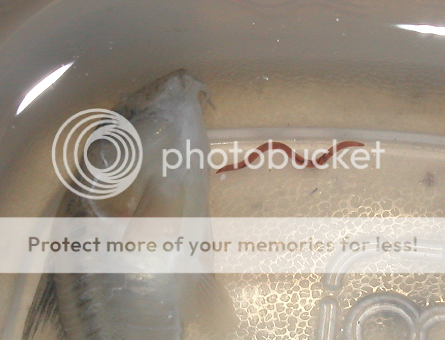I don't normally wander outside of the TFF marine and other inverts sections, but I've had a small problem between yesterday and today with one cory cat that I need help with. I would post in the emergency section, but the fish went from normal and healthy to dead in about 2-3 hours, so it's not exactly urgent anymore. I'm mainly trying to figure out what I've seen and whether I need to worry about other fish. Already had a look through all the FAQs and stickies I could find here and didn’t see anything that matched. If I've landed in the wrong section, I apologize to the mods in advance.
I left the tank room last night to get dinner, came back and one cory cat was dead with massive internal bleeding on its right side near the pectoral fin and up under gills. It was happy and eating before I left, and it had grown quite a bit since I got it so it seemed overall healthy. The bleeding and bruising it turned up with looked a lot like some sort of physical trauma. I removed the dead cory cat to a container of tank water overnight and, well....a surprise appeared:

The fish had been dead for over 12 hours when the photo was taken, so a combination of the flash from the camera and the clouding up of the skin has somewhat obscured the bruising and internal bleeding that was quite clear immediately after death. The worm is ~1/2", unsegmented. No way it could have been dragged into the container by accident; the fish was well-examined prior to being put in a container of water that also contained no such worms. I have had no possible parasite problems in any of my tanks until this event, and I’m unsure whether the worm and bleeding are related, or if it really was trauma and the worm coming out is just a coincidence. I'm going to get the worm under higher magnification later to see if I can find any other idenfitying features.
Details on the tank in question in case it helps: 20g long with some plants, 2x HOTB whisper filters + UGF. Yesterday the stock was 4 cory cats, one blue gourami, and one pleco. Stats were pH = ~7.8, ammonia/nitrite=0, nitrate=~20 with weekly changes. The tank has been set up for ~2 years with various stocking changes over time as other tanks have been set up and modified. I have been trying to get another tub with more floor space worked out for the pleco as he's gotten a bit large, but otherwise it's been a healthy tank although a bit crowded recently while I've been shifting things around.
Of course, I'm kicking myself for having been sloppy with record keeping the past several months. I have many tanks and now unfortunately can't recall exactly what went in and out this particular tank and when.
I left the tank room last night to get dinner, came back and one cory cat was dead with massive internal bleeding on its right side near the pectoral fin and up under gills. It was happy and eating before I left, and it had grown quite a bit since I got it so it seemed overall healthy. The bleeding and bruising it turned up with looked a lot like some sort of physical trauma. I removed the dead cory cat to a container of tank water overnight and, well....a surprise appeared:

The fish had been dead for over 12 hours when the photo was taken, so a combination of the flash from the camera and the clouding up of the skin has somewhat obscured the bruising and internal bleeding that was quite clear immediately after death. The worm is ~1/2", unsegmented. No way it could have been dragged into the container by accident; the fish was well-examined prior to being put in a container of water that also contained no such worms. I have had no possible parasite problems in any of my tanks until this event, and I’m unsure whether the worm and bleeding are related, or if it really was trauma and the worm coming out is just a coincidence. I'm going to get the worm under higher magnification later to see if I can find any other idenfitying features.
Details on the tank in question in case it helps: 20g long with some plants, 2x HOTB whisper filters + UGF. Yesterday the stock was 4 cory cats, one blue gourami, and one pleco. Stats were pH = ~7.8, ammonia/nitrite=0, nitrate=~20 with weekly changes. The tank has been set up for ~2 years with various stocking changes over time as other tanks have been set up and modified. I have been trying to get another tub with more floor space worked out for the pleco as he's gotten a bit large, but otherwise it's been a healthy tank although a bit crowded recently while I've been shifting things around.
Of course, I'm kicking myself for having been sloppy with record keeping the past several months. I have many tanks and now unfortunately can't recall exactly what went in and out this particular tank and when.


